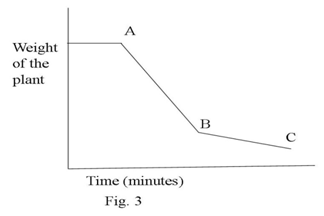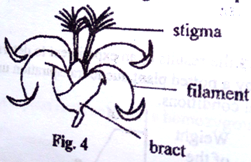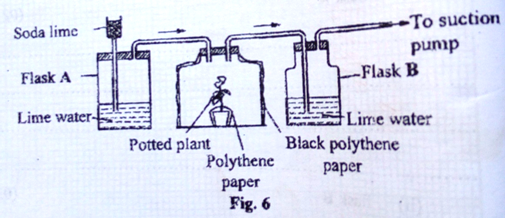1. .Which of the following are likely blood group-s of children from parents of blood group A and B
A. O only
B. AO only
C. O and AB only
D. O, A, B and AB.
2. Which one the following pairs of the human’s eyes refracts light?
A. cornea and choroid
B. A aqueous and vitreous humors
C. cornea and iris
D. iris and ciliary
3. An advantage that a lizard has over a cat is that it.
A. has constant metabolic rate.
B. has a lower food consumption per unit body mass
C. can live in any environment
D. is active through out the day
4. Which one of the following methods of controlling malaria does not harm the environment?
A. draining ponds
B. use of insecticide such as DDT
C. Spraying oil on top of water ponds.
D. Introducing fish ponds.
5. Part of section of showed irregular shaped cells which were loosely packed and few chloroplasts. The part of leaf is most likely to be that of the
A. Spongy mesophyll layer.
B. palisade mesophyll layer
C. upper epidermis
D. Lower epidermis.
6. A silo sample characterized by good aeration ,high drainage, low capillarity and loose particles is
A. clay
B. loam
C. sand
D. Laterite.
7. The following is a dichotomous key of inverterbrates
(1) (a) has 8 legs………………………..W
(b) Has 6 legs………………………..2
(2) (a) has long antennae……………X
(b) Has short antennae………….3
(3) (a) has proboscis……………………..Y
(b) Has mandibles…………………..Z
Which one of the organisms is a fly?
A. W
B. X
C. Y
D. Z.
8. Which one of the following is a difference between nervous and endocrine coordination
Nervous Endocrine
A. Message are transmitted slowly Message are rapidly transmitted
B. Effects are localized. Effects are widespread.
C. Produce long lasting effects Produce short widespread.
D. Massage is chemical Message is electrical.
9. Figure 1 is a diagram of a seedling.

The region that elongates most rapidly during epigeal germination is indicated by letter
A. L
B. M
C. N
D. O.
10. Which one of the following organisms reproduce by budding?
A. chromatids separate and move to opposite poles
B. chromosomes uncoil
C. chromosomes line at the equator
D. chromatids collect together at the opposite ends
11. Which of the following organisms reproduce by budding?
A. bacteria
B. spirogyra
C. amoeba
D. Fungi.
12. The hormones that stimulate the growth of pubic hairs in humans are
A. oestrogen and testosterone
B. Progesterone and luteinising hormone.
C. Luteinsing hormone and progesterone.
D. follicle stimulating hormone and progesterone
13. Which one of the following constituents of blood is not found in the glomerular filtrate?
A. urea
B. protein
C. water
D. Glucose.
14. At a temperature of 300c for sometime. four test tubes, each with contents as indicated in the following table, were incubated
|
Test tube |
Contents |
|
1 |
Albumen + pepsin |
|
2 |
Albumen + dilute hydrochloride acid |
|
3 |
Albumen + pepsin + dilute hydrochloric acid |
|
4 |
Albumen + boiled pepsin + dilute hydrochloric acid. |
In which test tube did the content become clear?
A. 4
B. 3
C. 2
D. 1.
15. Figure 2 is an experiment set up to demonstrate anaerobic respiration in yeast.

The importance of liquid paraffin in the experiment is to
A. React with yeast and glucose
B. Speed up the reaction between yeast and glucose
C. Exclude atmospheric oxygen from the yeast –glucose mixture
D. Expel all the oxygen in the solution.
16. Which one of the following describes the change from plant protein to ammonium compounds?
A. fermentation
B. Denitrification
C. putrefaction
D. nitrification
17. Agene which foes not express its elf unless in a homozygous state is
A. Dominant
B. Sex-linked
C. Codominant
D. Recessive
18. Which one of the following groups of organisms in a food chain contains the least amount of energy?
A. Tertiary consumers
B. Secondary consumers
C. Primary consumers
D. Producers.
19. Figure 3 shows the results of an experiment to determine the amount of water lost by a potted plant due to transpiration under different environmental conditions.

The most likely conditions under which the experiment was conducted between points A and B were in
A. Adak room and the plant covered with a wet polythene bag
B. An open place, in bright sunlight.
C. A cold and humid place.
D. A humid and shady place
20. The type of pollination that the flower in figure4 is adapted for is

A. Cross pollination
B. self pollination
C. wind pollination
D. Insect pollination.
21. A characteristic feature of thoracic vertebra is the presence of
A. Short transverse processes.
B. vertebraterial canals
C. A large centrum.
D. Along neural spine.
22. In a mammalian heart ,the left ventricle is more muscular than the right because it
A. Pumps a lot of blood to the lungs
B. Pumps blood to all parts of the body.
C. Receives blood from all parts of the body.
D. Receives more blood
23. Which one of the following organisms does not transport oxygen by the blood?
A. cockroach
B. frog
C. bird
D. Fish.
24. An athlete breathes 500cm3 of air at each breath. His breathing rates is 40 breaths per minutes. If the atmospheric air contains 15% oxygen by volume, what is his oxygen intake per minute?
A. 30000 cm3
B. 2000 cm3
C. 600 cm3
D. 300 cm3
25. Bile salts help in the digestion of salts by
A. Neutralizing excess stomach acids.
B. Converting fats into simpler substances.
C. Breaking fats I into smaller particles
D. Separating fatty acids from glycerol
26. The growth of a plant shoot towards light is induced by
A. Lack of auxins on the dark side.
B. A higher distribution of auxins on the light side.
C. A higher concentration of auxins at the tip of the shoot.
D. A higher distribution of anxins on the dark side.
27. Removal of a ring of bark from a tree trunk interferences with the movement of
A. Water to the leaves
B. Mineral salts to the leaves
C. Food to the leaves
D. Food to the roots
28. Some plants produce large quantities of pollen grains because
A. Some of the pollen grains to not mature.
B. Much of the pollen grains never reach the stigma
C. The pollen is needed by bees.
D. The pollen gives a nice scent to the plant
29. Vasodilation is likely to occur together with
A. Vasoconstriction.
B. shivering
C. sweating
D. Increased metabolism.
30. The most likely habitants of a plant with stomata on the surface of its leaves is
A. Water
B. Salty marsh
C. High altitude
D. Desert
31. (a)State the organ in the human body that secretes insulin e
(a) Explain why a person suffering from diabetes
(i) Has to be given regular doses of insulin.
(ii) Has to eat more frequently.
(iii) Glucose and not sucrose is recommended to be given to an athlete after a race. Explain this observation.
32. (a) with the help of diagram ,describe sexual reproduction in Rhizopus
(b) Outline different ways in which fungi are important.
33. (a) Describe the structure of the different types of skeletons in animals giving an example in each case.
(b) Explain how the vertebral column in mammals is adapted to its functions.
34. Figure 5shows four A,B,C,D each filled with hot water at 700C and left to cool .flask A is insulated with dry cotton wool, flask B with wet cotton wool, flask C is not insulted and flask D smaller in size and not insulated .the flasks represent mammalian bodies.

The table below shows the temperature in each flask in figure 5, recorded at10minutes intervals for 30 minutes
|
Flask |
(temperature(0C)AT 10 minute intervals) |
|
|
|
|
|
10(min) |
20(min |
30(min) |
|
|
A |
70 |
66 |
62 |
60 |
|
B |
70 |
50 |
38 |
30 |
|
C |
70 |
60 |
53 |
48 |
|
D |
70 |
53 |
40 |
38 |
Study the information and answer the questions that follow;
- For each flask draw a graph to show the changes in temperature with in the space on next page .use the same X and Y axes for all the graphs.
- Calculate the average rate of cooling in each flask.
- Explain the rate of cooling in
i)Flask A
ii)Flask B
iii)Flask C
iv)Flask D
d)From the information, state two factors that the rate of cooling from a body.
35. Figure 6 is an experiment set-up to investigate a process in plants

(b) Name the process being investigated.
(c) Explain
(i) The ball jar was covered with black polythene paper
(ii) Part of the plant was covered with polythene paper.
(iii) Soda lime was used in the experiment
(d) State what would be observed in flasks A and B at the end of the investigation.
(i) Flask A
(ii) Flask B
(iii) Explain the results stated in c(i) and (ii)
(e) State what would be observed in flasks A and B if the set-up was placed in a dark room
(i) Explain your answer in d (i)
36. (a) Explain how the action of muscles causes carbon dioxide to pass from the lungs into the atmosphere.
(b) How does oxygen move from the air the alveoli into body tissues?
(c) How are respiratory surface adapted to their functions?
37. (a) Describe two ways in which the white blood cells defend the body.
(b) Explain how red blood cells are adapted to their function.
(c) Describe the changes that occur in an individual’s blood if the person moves from a low land and goes to live on a high land. Explain your answer.
